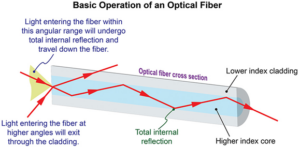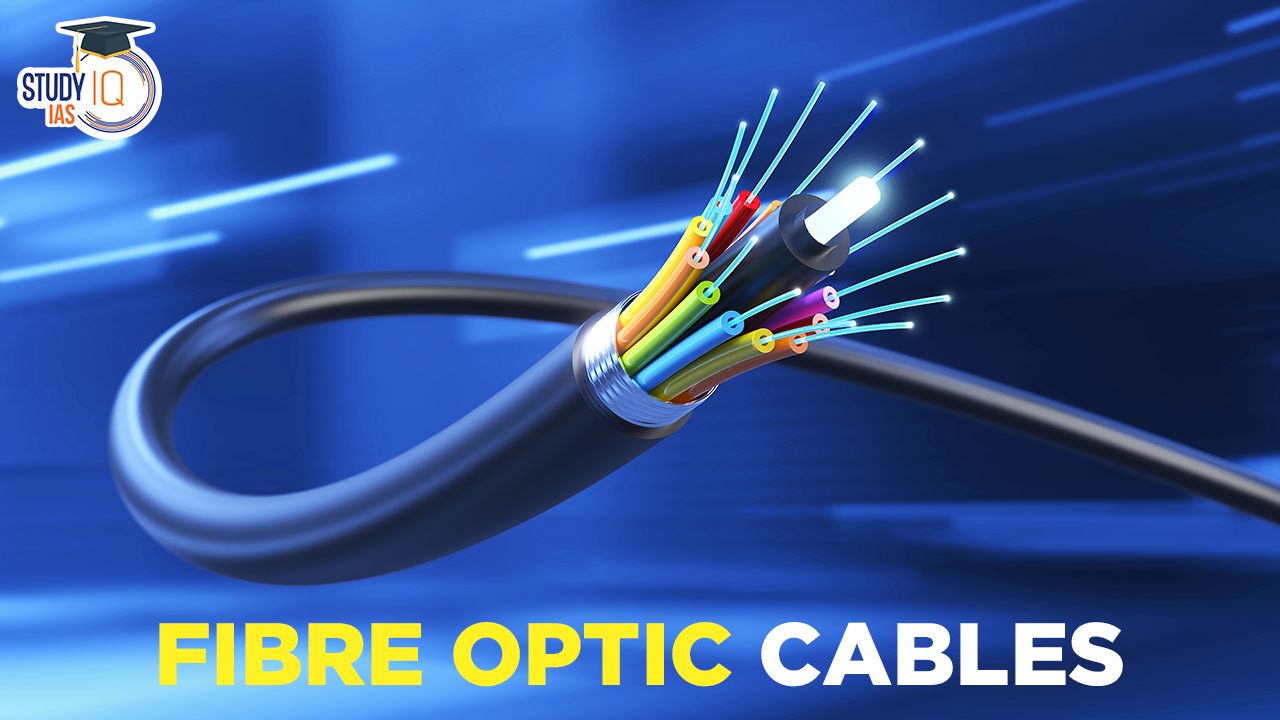Table of Contents
Context: With advancements in quantum optics and fibre optic communication, we are on the brink of a new technological era.
What is an Optical Fibre?
Optical fibres, composed of extremely thin cylindrical glass strands, are capable of transmitting various forms of information, including text, images, videos, and phone calls, as digital data over long distances nearly at light speed. These fibres, when encased in protective materials, become durable, lightweight, and flexible, making them suitable for underground or underwater installation.
A fibre-optic cable, akin to an electrical cable, contains one or more optical fibres for light transmission. This technology enables high-speed data transmission and is unaffected by external factors like lightning or adverse weather conditions.
We’re now on WhatsApp. Click to Join
Uses of Optical fibre
- Telecommunications: It is used to transmit voice, video, and data all over the world.
- Networking: Optical fibre is also used in computer networks. It is a much faster and more reliable way to transmit data than traditional copper cables.
- Medical imaging: Optical fibre is used in medical imaging devices, such as endoscopes and lasers.
- Sensors: Optical fibre is used in sensors that measure things like temperature, pressure, and vibration.
- Other Uses: Automotive industry, CCTV cameras, Television cables, etc.
Types of Fibre Optic Cables
There are two primary types of fibre optic cables:
Single-mode fiber (SMF)
Single-mode fiber cables carry light in a single mode or path, allowing for longer transmission distances and higher bandwidths. They are typically used for long-distance telecommunications and data transmission, such as connecting cities or countries.
Characteristics
- Carries light in a single mode or path
- Longer transmission distances (up to 80km)
- Higher bandwidths (up to 100Gbps)
- Smaller core diameter (typically 9μm)
Applications
- Long-distance telecommunications
- Data transmission between cities or countries
- High-speed fiber optic networks
Multimode fiber (MMF)
Multimode fiber cables carry light in multiple modes or paths, enabling shorter transmission distances and lower bandwidths. They are commonly used for shorter-distance applications, such as within buildings or data centers.
Characteristics
- Carries light in multiple modes or paths
- Shorter transmission distances (up to 500 meters)
- Lower bandwidths (up to 10Gbps)
- Larger core diameter (typically 50μm or 850μm)
Applications
- Short-distance data transmission
- Local area networks (LANs)
- Fiber optic cabling within buildings
- Data centers
How Does Fibre Optics Work?
- Fibre optics operate on the principle of total internal reflection (TIR) to efficiently transmit light over long distances with minimal loss of optical power.
- This process occurs when light passes from a medium with a higher refractive index to a medium with a lower refractive index, leading to the light being completely reflected back into the initial medium.
- Total internal reflection takes place when the angle of incidence exceeds the critical angle, which is the angle at which the refracted ray runs parallel to the boundary between the two media, resulting in a refraction angle of 90°.

- Light in a fibre optic cable is able to travel by continuously reflecting off the cable’s internal walls until it reaches its destination.
- Consequently, signals encoded as electromagnetic waves can be input at one end of an optical fibre.
- These signals then reflect multiple times within the glass walls while travelling great distances, carrying the encoded information.
Components of fibre Optic Communication
A fibre optic communication system comprises three primary components:
- Transmitter: This part converts information into optical signals, typically represented by quick pulses of light that signify binary data (zeros and ones).
- Optical Fibre: This medium transports the optical signals to their intended destination.
- Receiver: This component decodes the optical signals back into the original information.
Production Of Fibre Optics
- Preform Creation: Initially, a high-purity glass rod with a specifically engineered refractive index profile, known as a preform, is created using chemical vapour deposition.
- Melting and Drawing: The preform is then heated to approximately 1,600 degrees Celsius, causing it to melt. Following this, it is drawn out into a thin, lengthy fibre.
- Diameter Reduction and Coating: During the drawing process, the fibre’s diameter is reduced while its length is maintained. The resulting thin fibre is then coated with a protective layer to enhance its strength and durability.
Fiber Optic Cables in Ocean
Fiber optic cables play a crucial role in modern communication, providing the backbone for global internet connectivity. Thousands of miles of fiber optic cables are laid beneath the oceans, forming the vast submarine cable networks that connect continents and enable seamless data transmission worldwide.
Significance of Submarine Fiber Optic Cables
Submarine fiber optic cables offer several advantages over traditional satellite communication:
- High Capacity: Fiber optic cables can transmit vast amounts of data at incredibly high speeds, enabling the transfer of massive amounts of information, including videos, streaming services, and cloud-based applications.
- Low Latency: Submarine cables offer lower latency compared to satellite communication, meaning data transmission experiences minimal delays, crucial for real-time applications like video conferencing and online gaming.
- Reliability: Fiber optic cables are less susceptible to interference and outages compared to satellite communication, ensuring more reliable and consistent data transmission.


 India to Host First Global Conference on...
India to Host First Global Conference on...
 How Terror Networks Abuse Digital Tools
How Terror Networks Abuse Digital Tools
 United Nations Population Award 2025: Va...
United Nations Population Award 2025: Va...





















